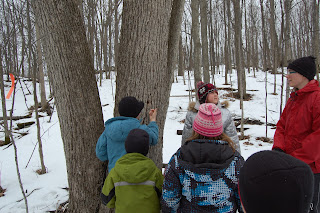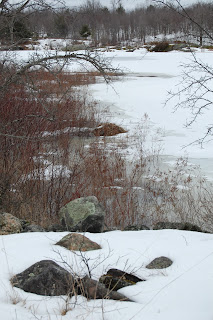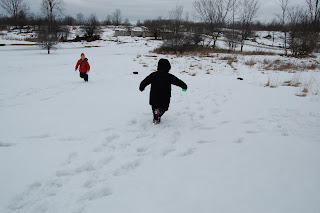Volunteer extraordinaire Alida Lemieux (who is an interpreter at Murphys Point in the summer) joined us again and led a great program all about "the sap that binds us." We started off with a hike along the Lally Trail where we used our tree-identification skills from the week before to pick out some sugar maple trees. Alida taught us a trick to identifying the sugar maple leaf - the lobes are "U" shaped (instead of "V" shaped) and the word "sugar" has a "U" in it. She then explained, using a tree volunteer, how the sap in the tree carries nutrients from its roots to its buds, and extra sugar in the sap works as an antifreeze as winter changes to spring - protecting the tree.


At the next stop we learned how many different creatures use the sap produced in maple trees to survive. One of these creatures is a woodpecker called the yellow-bellied sapsucker. It has - you guessed it - a yellowish belly and it likes - you guessed it - to suck the sap out of trees. The holes it makes attract insects, which draw in other creatures, too, forming part of the food chain. We also had the chance to see a hole made by the pilleated woodpecker, which is a much larger bird.


The next stop featured signs that a person had been tapping a tree. It was a single hole, not too deep, but very round - possibly done using a drill.

We then reached Black Creek, where we took a moment to scope out the beaver lodge, muskrat push-ups and various tracks. Alida and Steph had observed an otter on the ice earlier in the afternoon, but it was nowhere to be seen when the group arrived. A couple of big, soaring birds made an appearance in the distance, though!


Alida then showed us how, in theory, one would tap a tree using an old-fashioned wood auger, spiles and sap buckets. We discussed how the lids help to keep things out of the buckets, and how modern syrup operations have different equipment that removes unwanted items from the sap, such as moths and other bugs. Some of our participants are very knowledgeable about maple syrup production!
We then played a game that demonstrated sugar energy transfer by passing sugar around to show how each part of the food chain is affected by sugar maple sap at its start - with birds, insects, cats, fishers and fungus all playing a role. It truly is the sap that binds us!

The last stop on the hike featured a special guest! A visitor from the 1870s talked a bit about how hard families worked to produce maple syrup on family homesteads. She said she had to carry buckets of sap to the big outdoor iron kettle they used to boil the sap. She explained that often they would boil it past the syrup stage and into sugar, which stored more easily and could be sold at markets in Perth. She also told us about a couple of tricks to use when boiling the sap that help to keep it controlled and to remove unwanted particles.

We then made our way back to the drive shed to play some games. The first was a relay. Each team had to carry a small container of "sap" from one bucket to a pot as fast as possible. Emptying the first bucket fastest didn't necessarily mean that team won - there were obstacles to overcome (such as a squirrel in the kettle or horses running out of control and dumping the sap wagon). The team with the most "sap" won!
The second game was a human chain to represent a pipeline for sap collection. The kids were the links in the chain and had to pass a ball hand to hand until they reached the end of the line.
At last it was snack time, which featured dill pickles and crackers to counter the sweetness of taffy on snow (yum!) boiled up by Skipper Jane.
A huge thank you to Alida for travelling all the way back to Murphys Point to lead another great program for us, and to our volunteers Jane Irwin, Pat Batchelor and Stephanie Gray.
We had a terrific time with our SKIP kids this session. Stay tuned for news about the Spring session - to be announced.


























